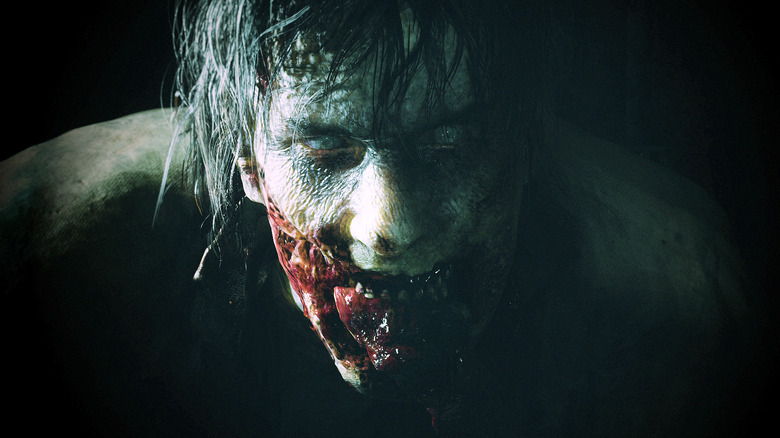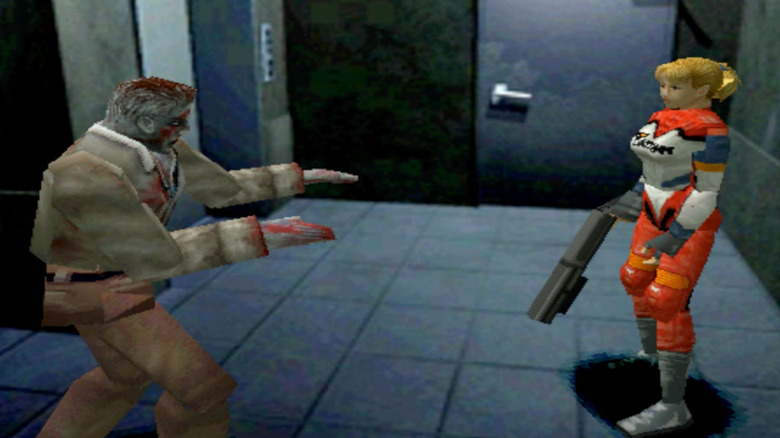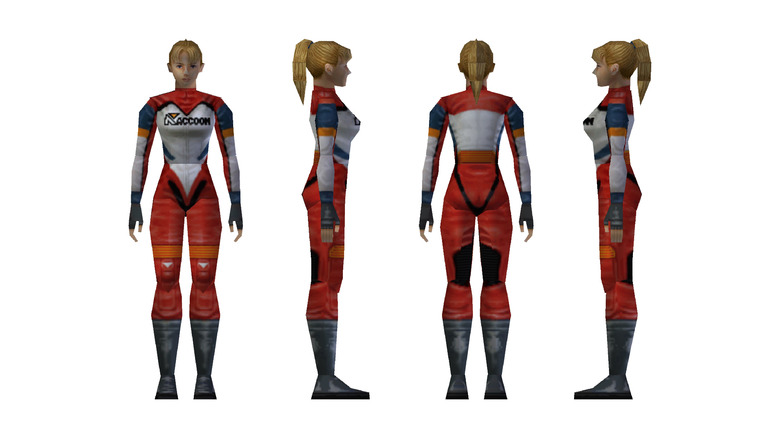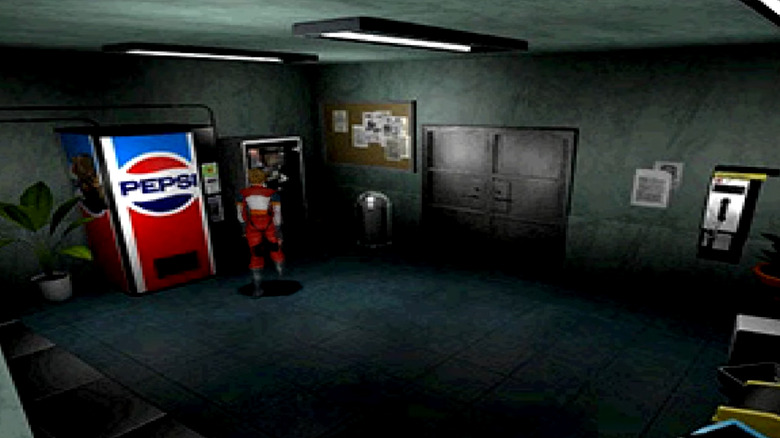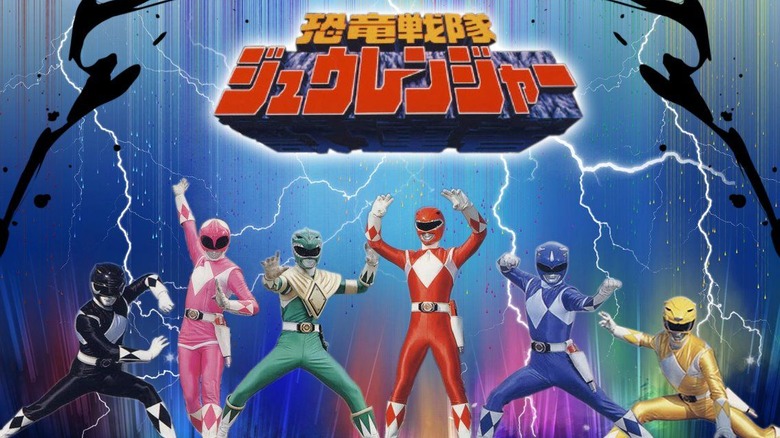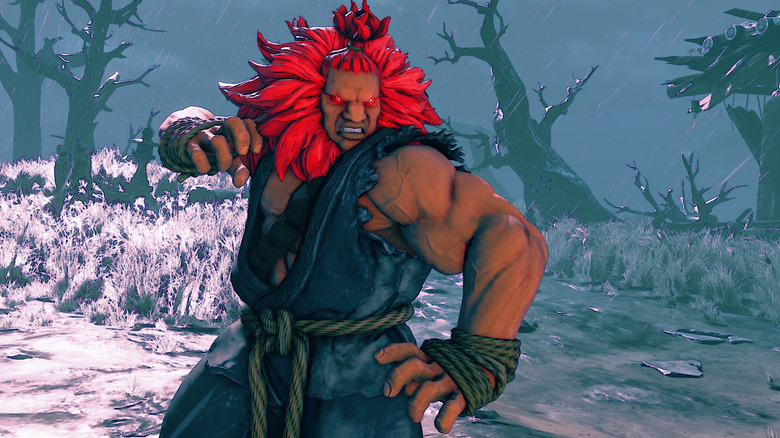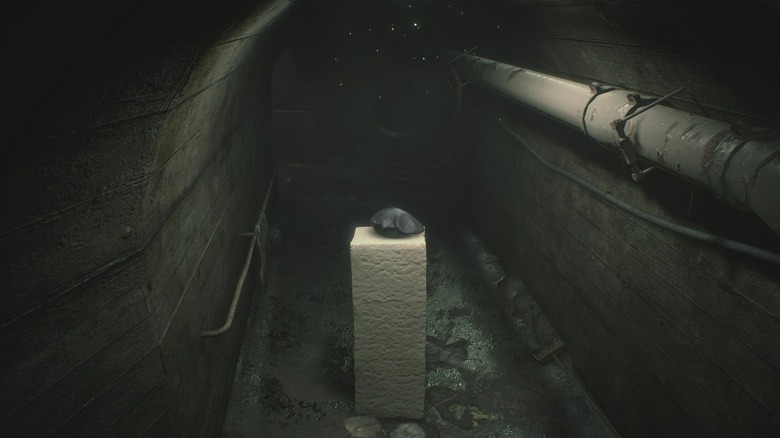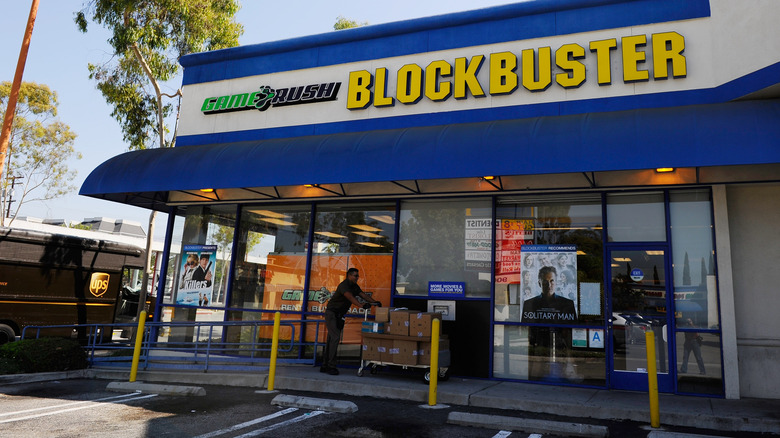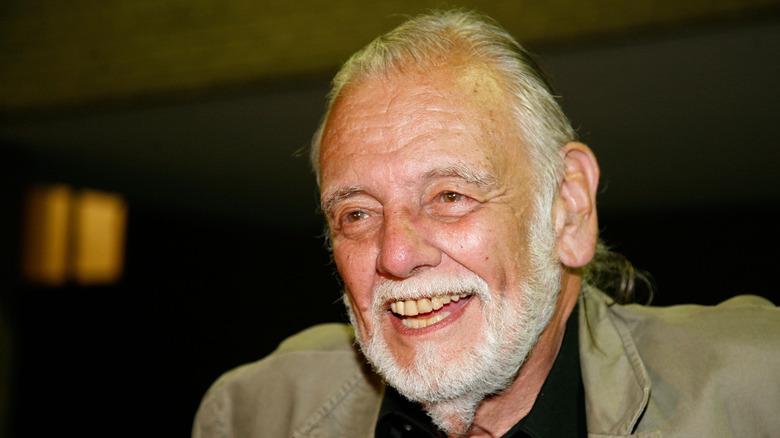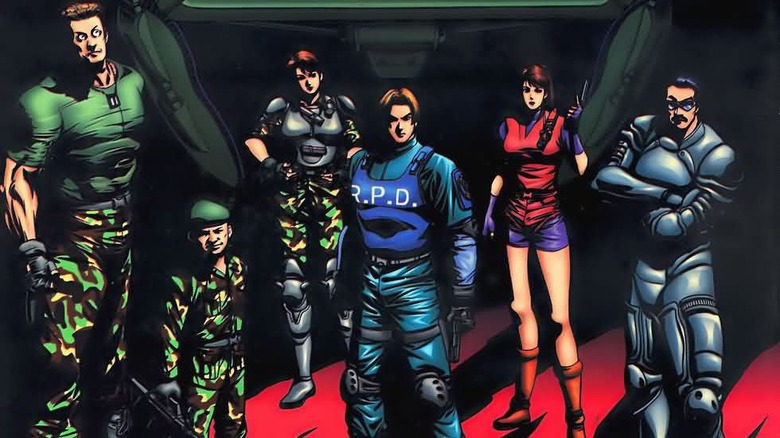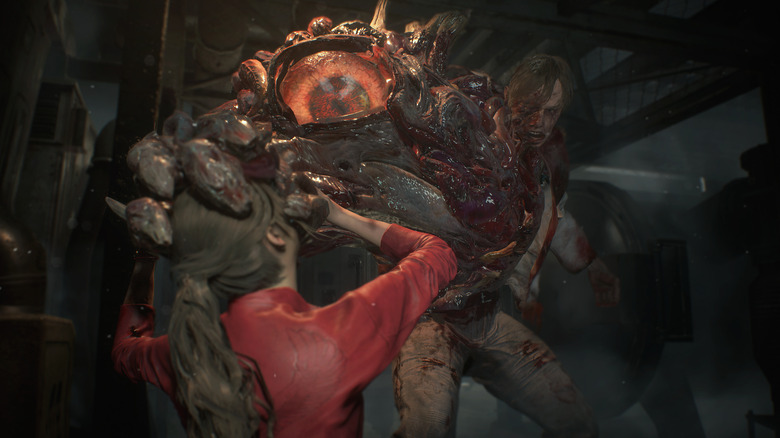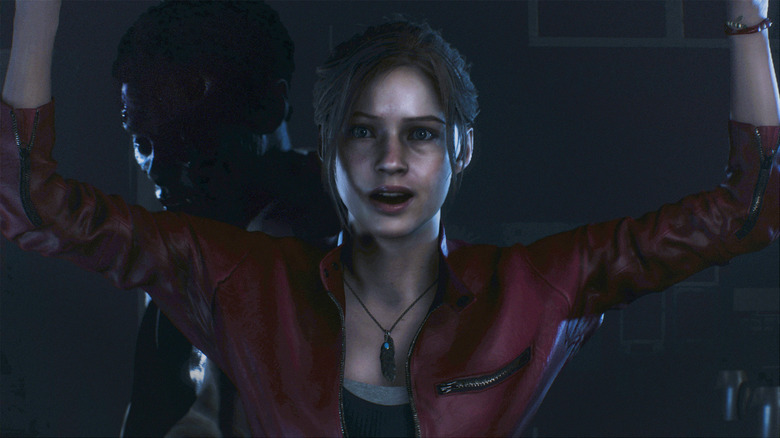The Untold Truth Of Resident Evil 2
We may receive a commission on purchases made from links.
Back in the '90s, well before Dead Rising, The Walking Dead, and Call of Duty became household names, there was really only one place in gaming you could go if you wanted a Hollywood-style zombie adventure: Resident Evil 2. By shifting the action to Raccoon City, adding the "zapping system" that changed the game based on the order that you tackle the game's dual plotlines, and introducing fan-favorite characters like Leon Kennedy, Claire Redfield, and Ada Wong, Resident Evil 2 improved on its predecessor in almost every way. No wonder fans were so eager for a remake.
Resident Evil 2 was a classic from the moment that it was released, but it was far from a sure thing. Behind-the-scenes, the Resident Evil 2's story is full of just as many twists and turns as any of Umbrella Corp and Albert Wesker's topsy-turvy schemes. The craziness didn't stop in 1998, either. The modern remake had its share of ups and downs, too. Here are some of the highlights.
The Resident Evil 2 that wasn't
Resident Evil became a hit almost immediately, and production on a sequel began right away. From the very beginning, however, Capcom's development team ran into trouble. Tokuro Fujiwara, the designer who pitched Resident Evil, left the company in 1995 to pursue his own original ideas. Kenichi Iwao, Resident Evil's writer, departed for Square. The first game's director, Shinji Mikami, decided he'd rather produce the sequel. His replacement, Hideki Kamiya, had never directed a game before. He didn't like horror much, either.
Still, Capcom desperately needed a hit, and Mikami and Kamiya did their best to give it one. A Resident Evil 2 demo appeared at the Tokyo Game Show in the summer of '96, just a few months after Resident Evil made its PlayStation debut, and was used for promotional material for nearly a year. Screenshots appeared in game magazines. By the end of '96, Resident Evil 2 was about 70% finished, and looked like it was on track to meet its 1997 release date. There was just one problem: it wasn't very fun to play.
Also? The plot didn't hold up. Brightly lit environments and a bigger emphasis on action robbed the game of its horror. And so, Mikami, Kamiya, and Capcom executives did what they had to do: scrap everything and start over. The results speak for themselves, but fans have never forgotten those early glimpses at the game now known as Resident Evil 1.5. In some ways, it remains Resident Evil's biggest mystery.
Goodbye Elza, hello Claire
Fundamentally, Resident Evil 1.5 and Resident Evil 2 aren't that different. They're both survival horror games. They both have zombies. They are not, however, the same game. While both versions of Resident Evil 2 starred Leon Kennedy as one of its two playable heroes, Claire Redfield didn't exist in Resident Evil 1.5. Instead, the game's second protagonist was Elza Walker, a motorcycle racer who traveled to Raccoon City to start college and got caught up in the chaos by accident. Many supporting characters were different, too, including the various civilians and officers that would help Elza survive the RCPD headquarters.
Those weren't the only differences between the two games, either. Key environments, like the RCPD and the sewers, had different layouts and themes. In Resident Evil 1.5, Umbrella Corp is dead and gone, and the game's main threats come from creatures who escaped the Spencer Mansion. Resident Evil 1.5 had two plotlines, but unlike Resident Evil 2, they didn't intersect. Resident Evil 1.5 used low-poly zombie models to cram as many monsters on the screen as possible, even though oversaturating the game with undead nasties robbed them of their horror.
When the reboot came, many side characters were reconfigured or cut entirely, and Elza morphed into Claire Redfield, sister of Resident Evil co-star Chris. Elza lives on in the Resident Evil 2 remake as an alternate skin for Claire, but you'll need to pay to see her: right now, the outfit is only available to fans who purchase the Resident Evil 2 Remake Deluxe and Collector's editions.
How Resident Evil 1.5 rose from the grave
Resident Evil 1.5 might be gone, but it's not forgotten. Reports indicate that Resident Evil 1.5 was a good 60 to 80% complete when it was cancelled, and while Shinji Mikami claims that Resident Evil 1.5 was "no fun" in interviews, that doesn't seem to matter. It's Resident Evil. People want to play it.
Some fans resorted to extreme measures to do so. When Resident Evil 5 came out, players hacked the multiplayer leaderboards to send Capcom a message: "Release RE1dot5. We were waiting it for 15 years." Others have taken a more productive approach. Over time, Resident Evil 1.5 prototypes leaked out. Using the unfinished builds as a base and filling in the gaps with screenshots, videos, old documentation, snippets of code found in Resident Evil 2 demos, and some unofficial "official" support from people at Capcom, fans are trying to rebuild Resident Evil 1.5 from the ground up.
The most successful effort so far comes from Team IGAS, which estimates that it has what it needs to accurately recreate about 95% of the game. IGAS team members have to fill in the rest of the blanks themselves. Resident Evil 2 provides the template for boss fights. Dialogue is extrapolated from pre-written plot points. The end result isn't a perfectly accurate recreation of Resident Evil 1.5, but for a game that wasn't actually released? It's pretty darn good.
From Angel Grove to Raccoon City
Resident Evil is Capcom's best-selling franchise, but that wasn't inevitable. The series was originally supposed to end with Resident Evil 2, so if you enjoyed Resident Evil 3, Resident Evil 4, Resident Evil 7, or spin-offs like Revelations or Code Veronica, you've got one man to thank: Noboru Sugimura, the writer who came in to rescue Resident Evil 2 and transformed the franchise into the one that we know and love today.
When it became clear that Resident Evil 2 wasn't working, Mikami and Kamiya recruited Sugimara, an experienced screenwriter, to help revise the game's plot. As Sugimara read over the game's scenarios, he had one big suggestion: "You should probably re-write these again." Remarkably, Mikami and Kamiya took Sugimara's advice. They threw out all of their work and started over from scratch, with Sugimara playing a fundamental role in shaping the game's narrative.
Sugimara is the one who insisted that Resident Evil 2, which originally stood alone, pick up the plot threads from Resident Evil. He's the one who planted the seeds for a long-running Resident Evil franchise. Sugimara is responsible for making Resident Evil's trademark weirdness a franchise staple (the early version of Resident Evil 2 was "too realistic," Sugimara said).
If you're a '90s kid, Resident Evil 2 isn't the only fond memory that Sugimara is responsible for, either: before he took his talents to Raccoon City, Sugimara was the lead writer for the Japanese kids' show Kyōryū Sentai Zyuranger, which was re-edited into the first season of Mighty Morphin' Power Rangers.
Like a zombie, you can't keep a good prank down
By now, Electronic Gaming Monthly's 1992 April Fools' Day joke is legendary. Back in the early '90s, when Capcom's Street Fighter 2 was dominating arcades, the venerated gaming magazine turned a mistranslation into a nasty trick, telling players that they could unlock a secret fight against a boss character named Shen Long if you performed some remarkably specific actions. The list of requirements was absurd, but fans bought the rumor hook, line, and sinker.
Shen Long wasn't real, but he did make an actual contribution to Street Fighter lore. Hoping to make good with fans who were burned by EGM's bogus report, Capcom introduced a hidden boss in Super Street Fighter 2 Turbo named Akuma who, like Shen Long, dressed kind of like series mascot Ryu, and who used super-powered versions of Ryu and Ken's moves. Unfortunately, the Shen Long prank didn't end there. Years later, EGM honored the Shen Long gag with an Akuma-themed sequel — and while you might've thought that fans would've learned their lesson, they fell for it again.
According to EGM, players could play as Akuma in Resident Evil 2 by beating the game's two campaigns six times with an A rank, relying solely on the handgun and combat knife, and then entering Akuma's name on Resident Evil 2's laboratory-based computer screen. EGM even had screenshots to prove it. Eventually, players proved that EGM-fueled fantasies of scorching zombies with hadoukens were dreams and nothing more, but the stunt did give rise to a popular saying: Fool me once, shame on me. Fool me twice, and it must be EGM's fault.
The untold truth of tofu
When Capcom announced that Tofu Survivor was returning for the Resident Evil 2 remake, long-time fans rejoiced. Other people had more reasonable reactions: "Huh?", "What the heck?", and "Seriously, tofu?"
If you're in the latter group, here's what the fuss is all about. In the original version of Resident Evil 2, players could unlock a bonus mode called The 4th Survivor by completing both of the game's campaigns with an A ranking. In The 4th Survivor, you control HUNK, a silent and menacing Umbrella Corporation soldier. Race your way through the campaign a few more times, and you'll also be able to play through The 4th Survivor as a sentient block of tofu who's armed with a knife, a couple of herbs, and little else. It's a goof, but it's also really hard.
But still: why tofu? Well, as the story goes, the Resident Evil 2 team used a giant white block to test collisions. "We'd spent a couple of years using that character," Capcom's Jun Takeuchi tells EGM. "By the time we'd finished, though, Tofu had become very important to us." Capcom's Resident Evil 2 staff members decided to show their love by immortalizing him in the game. Don't expect tofu to look the same this time around, though. For the remake, Capcom scanned actual tofu to make sure that its squishy texture is as realistic as possible.
The Blockbuster effect
In the old days, you didn't have to own a game to play it. You could just head down to the local Blockbuster and rent it. Video rental stores are largely a relic of the past — thanks, technology! — but in 1998, when Resident Evil 2 came out, Blockbuster Video and its ilk were thriving. Many '90s kids have fond memories of picking up a game on a Friday and playing non-stop in an effort to reach the finale before it had to go back to the shop a few days later.
Naturally, that wasn't great for publishers, who wanted to sell as many copies of their games as possible. Video game rentals are illegal in Japan, where Resident Evil 2 was made, but are allowed in America. For Capcom, that was a problem. "If the game could be completed in a few days, fewer units of the game would sell," Mikami tells the Resident Evil Comic Book Magazine. So, Capcom made Resident Evil 2's international edition more difficult, hoping that kids would have to purchase the game in order to finish it.
Mikami claims that the US version of the game is so much harder than the Japanese original that Capcom's internal R&D team had trouble finishing it. That's not the only difference between the two releases, either. The Japanese edition of Resident Evil 2 is less gory. When you die, you won't see any of Resident Evil 2's graphic eviscerations. Instead, your failure is commemorated by a simple fade to black.
The old Romero touch
Resident Evil 2 owes a huge debt to director George A. Romero, who created horror classics like Night of the Living Dead, Dawn of the Dead, Day of the Dead, and a number of other movies with "Dead" in the title. That's not surprising. The modern zombie genre sprung more or less fully formed from Romero's imagination (with a little help from a missing copyright symbol). Aside from a few tweaks here or there, zombie fiction has been pretty much the same since Romero's 1968 feature film debut.
Even so, Resident Evil 2 has even closer ties to George Romero than projects like The Walking Dead, 28 Days Later, or Zombieland. Romero didn't just inspire Resident Evil 2. He worked on it directly — kind of. To promote Resident Evil 2, Romero directed a 30-second ad that never aired outside of Japan, but don't mistake brevity for a lack of polish. The short, Romero says, was filmed and produced like a movie. Romero shot on location in an abandoned prison, dressed a horde of extras up in special effects makeup, and cast real stars like Brad Renfro and Adrienne Frantz as his leads.
Executives were so impressed that they hired Romero to develop a Resident Evil feature film, although Romero lost the gig when the script wasn't up to par. Still, Romero's contribution to Resident Evil lore lives on. While Romero passed away in 2017, a live-action trailer for the Resident Evil 2 remake is a gushing homage to Romero's original commercial. Yeah, Capcom really is remaking everything.
A story so nice they told it twi—um, a lot
Think that the 2019 remake is the first time that Resident Evil 2 has gotten a makeover? Think again. Years before Capcom announced that Resident Evil 2 would be getting a modern-day revision, the company retold Leon and Claire's story many, many times — and not just in video games, either.
The Nintendo 64 version of the game, for example, did away with the clunky tank controls, randomized item placement to keep later playthroughs fresh, and introduced the EX Files, which expanded on Resident Evil 2's lore. Resident Evil: Uprising retells the Resident Evil 2 story on mobile phones, with a scaled-down 2D interface to match. Resident Evil: The Darkside Chronicles remakes Resident Evil 2 as a Wiimote-controlled on-rails shooter.
Then you venture outside of video games, and that's where things get weird. S.D. Perry's City of the Dead, the game's official novelization, adds a new character named Trent who's behind, well, everything. In Hong Kong, a 60-volume comic finished off the game's plot less than a quarter of the way through it's run, then went on to explore Leon and Claire's fight against "God," Umbrella Corp's former CEO who also happens to be a brain in a jar. There's even a Taiwanese comic, Demon Castle II, that reframes Resident Evil 2 as a romantic comedy featuring a love triangle between Leon, Claire, and Ada Wong. Yes, we're just as sad as you are that we can't find a copy of that in English.
Bigger and (maybe) better
Just in case you haven't heard, making video games is challenging, and as time goes on and technology improves, it's only getting harder. Look at Resident Evil 2, for example. It wasn't an easy game to make. Capcom's audio engineer forced a cinema-quality experience out of the PS1's meager sound chip, but accidentally made Resident Evil 2 a two-CD game in the process. Resident Evil 2 marked the first time that Capcom had recorded English voice-overs overseas, which caused all kinds of headaches. Its detailed character models and pre-rendered backgrounds were cutting edge, but making Resident Evil 2 was such a chore that it drove director Hideki Kamiya to find solace in nightly glasses of brandy and hungover mid-day naps.
All of that, and how many people did it take? According to The Resident Evil Comic Book Magazine #3, only 50. And how many worked on the 2019 remake, which covers a lot of the same ground? Over 800.
Of course, the Resident Evil 2 remake is more technologically advanced than its predecessor, and it's easy to see where that extra manpower went. While Resident Evil 2's original artists based cutscenes on action figures, the people steering the remake used a fully-equipped motion capture studio. Moving from fixed camera angles to an over-the-shoulder view forced the developers to reimagine the game's puzzles, since key items could no longer be hidden off-screen. Amping up the horror forced Capcom to invent new audio technologies. That's a lot, but the results speak for themselves.
O Claire, Claire! Wherefore art thou Claire (and Leon, too)?
The 2019 take on Resident Evil 2 makes a lot of changes — it wouldn't be much of a remake if it didn't — but they're not all welcome ones. The modern graphics, improved controls, and updated puzzles are all welcome, but if you've noticed that Claire and Leon don't sound quite right, don't worry. It's not all in your head. In the original Resident Evil 2, Alyson Court played Claire Redfield. Leon Kennedy's original voice actor, Paul Haddad, only appeared in Resident Evil 2, but he was aptly replaced by Paul Mercier and, later, Critical Role dungeon master Matthew Mercer.
None of those actors are in Resident Evil 2 remake, and there's one big reason why: it all comes down to money. In a video posted during E3 2017, Court explained that she'd been approached to play Claire again and was excited about the opportunity, only to learn that Capcom and its partners subsequently decided to use non-union actors for the remake. A few weeks later, Mercer confirmed that he had the "same experience as Allyson [sic] regarding this project."
Nick Apostolides and Stephanie Panisello voice Leon and Claire in the remake, and they do a fine job. Still, it's hard not to feel a little icky about the whole thing. As Court explains, if Capcom went non-union to save a few bucks, that's "disrespectful" to both the fans and the original actors (especially Court, who played Claire in six out of her seven previous appearances), and puts an unfortunate blemish on an otherwise excellent game. For shame, Capcom. You should know better.

